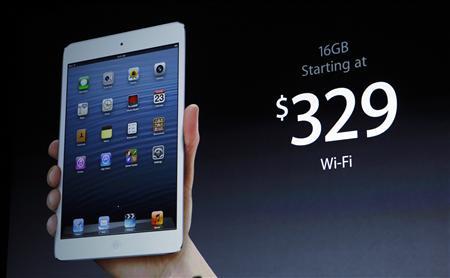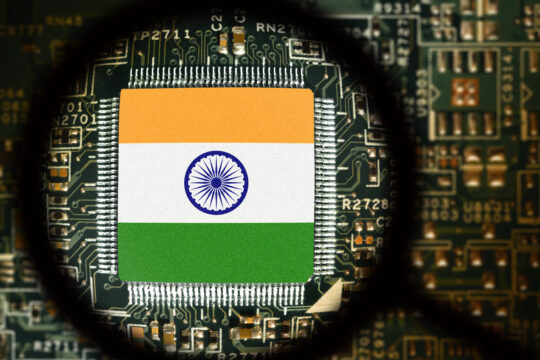The good: The iPad Mini’s ultra-thin and light design is far more intimate and booklike than the larger iPad, and its cameras, storage capacities, optional LTE antenna, and general functionality offer a full iPad experience. The display’s dimensions elegantly display larger-format magazines and apps.
The bad: The iPad Mini costs too much, especially considering the lower resolution of its 7.9-inch non-Retina Display. The A5 processor isn’t as robust as the one in the fourth-gen iPad and iPhone 5. Typing on the smaller screen is not quite as comfy.
The bottom line: If you want the full, polished Apple tablet experience in a smaller package, the iPad Mini is worth the premium price. Otherwise, good alternatives are available for less money.
The tablet landscape, at the smaller-screened end, has become about pricing. Or so it seems. Don’t tell that to the iPad Mini. Apple’s long-awaited, and finally real, tinier tablet is remarkably thinner and lighter than its big-boned newly arrived fourth-gen iPad sibling, but it also starts at $329, a price that’s well above the bargain-basement $199 target floated by devices like the Nexus 7, Amazon Kindle Fire HD, and Nook HD.
Certainly, the tablet playing field — especially when it comes to media — is leveling. The Kindle’s book, video, and app ecosystem is impressive in its own right. The Nook has made gains with its apps and services. Android has Google Play. Regardless, none of these can truly compare to the breadth of content from Apple’s App Store and iTunes. The App Store is Apple’s great gold mine, and the iPad Mini’s price seems to be banking on you knowing that. And, in that sense, the iPad Mini may be worth its price.
But, the original iPad hit a sweet-spot $499 price that few competitors could match. The Mini’s price is about $130 higher than many similar 7-inch tablets that undercut it. It’s even more expensive than some newly-arriving 8.9-inch tablets from Amazon and Barnes & Noble.
 (Credit: CNET)
(Credit: CNET)The iPad Mini is really a shrunken-down iPad 2. Or, a larger iPod Touch. The original iPadwas a larger iPod Touch, too, in a lot of ways. That didn’t make it any less appealing. Here, the use case isn’t laptop alternative — it’s Kindle alternative. This is a compact reader/viewer. Of documents, magazines, movies, games. Maybe even of editing or creating. And it’s spectacular at being portable.
What’s unique about the Mini? Without a doubt, it’s the design. It’s cute, it’s discreet, and it’s very, very light. It feels like a whole new device for Apple. It’s light enough to hold in one hand, something the iPad was never really able to achieve for extended periods of time. It’s bedroom-cozy. Other full-fledged 7-inch tablets feel heavier and bulging by comparison. This is a new standard for little-tablet design. It makes the iPad feel fresh. After a week of using the iPad Mini, it seems to find a way to follow me everywhere. It’s extremely addicting, and fun to use.
But oh, that screen. It’s not bad, not at all, but it’s not Retina Display. It’s not even as high-res as other 7-inch tablets. If you’re an obsessive over crisp text, you’ll notice the fuzziness. If you’re comparing the Mini to a laptop, you won’t. I wanted that display to be as good as the one on the iPhone 5, iPod Touch, and Retina iPad. It isn’t, not now. It mars the product for me, because otherwise, the screen size and its aspect ratio is perfect for handling comics, magazines, and reading apps.
 (Credit: CBS Interactive)
(Credit: CBS Interactive)
Is the iPad Mini worth its premium, at nearly $130 more than some of the competition? If you’re looking to invest in an iPad for the least amount of money, the answer is yes. If you’re investing in iOS-land for the first time, this is a very good starting point.
A Retina Display and a lower price would have made the iPad Mini perfect. The fourth-gen iPad, in contrast, is a superior device under the hood, with much faster performance and a better-quality screen. Still, for many people, the Mini will be preferable because it’s less expensive and perfectly portable. For others, it’ll be the second iPad — the kid iPad, the beach iPad. I love this iPad, I’m just not sure I need to own it.
(Editor’s note: we’ll continue updating this review with additional tests and full battery life results.)
Design
Regardless of your feelings of the Mini’s price, or its A5 processor and non-Retina 7.9-inch display, here’s what you’ll notice when you pick it up: it’s really shockingly nice to hold.
 (Credit: CNET)
(Credit: CNET)The iPad Mini is a design shift from the iPad, and perhaps the biggest one in the iPad’s entire history. Despite how popular the iPad’s been, it’s not really a device that’s very comfortable to use when not sitting down or at a desk. It’s a use-when-you-get-there device, or use-when-comfortably-seated. An iPhone or iPod Touch is truly mobile, and the iPad is only halfway there.
That’s no longer the case. The iPad Mini is an extremely easy-to-hold tablet that, despite its wider form, feels as light as a Kindle. Not a Kindle Fire, but a Kindle. At 0.28 inches thin and 0.68 pounds (0.69 for the LTE versions), it’s the slimmest and lightest 7-inch-range tablet around, although it has a larger footprint (7.87 inches by 5.3 inches). It’s thinner than an iPhone 5, and seems proportionally as razor-thin as the new iPod Touch.
 (Credit: CBS Interactive)
(Credit: CBS Interactive)
In fact, the iPad mini feels very much like the new Touch, even down to the curved wrap-around aluminum shell and flat back. It lies down far flatter than the fourth-gen iPad, more like a wafer. The headphone jack at the top and Lightning connector and speakers at the bottom are carved into less-tapered, more-curved side edges. Around the front glass is an angled aluminum bezel like on the iPhone 5. The white model, which I reviewed, has a standard aluminum back. The black model has a slate-colored anodized aluminum, giving it that same stealth look as the iPod Touch.
 Fourth-gen iPad, iPad Mini, iPod Touch.
Fourth-gen iPad, iPad Mini, iPod Touch.
(Credit: CNET)
With its extremely whittled-down side bezels, the iPad Mini’s not covered in large bezel like the larger iPad, which always made it resemble a MacBook screen that floated away from its keyboard. The Mini truly feels like a large iPod Touch, which is exactly what we used to call the iPad back in 2010. It’s far more apt now.
You probably won’t think that, though, because the iPad Mini won’t fit in your pocket, or even your jacket pocket. It’s more of a purse, small bag, or large-jacket pocket device. It’ll fit wherever you’d fit a softcover book.
The construction feels solid, stellar, fun to hold. The home button clicks crisply. It doesn’t feel like a lower-priced product in your hands. It might be, in terms of form, the most addictive iOS product in existence. And it’s perfectly sized for kid hands. It’s a far easier car device and travel device.
 (Credit: CNET)
(Credit: CNET)But, the Mini shouldn’t be a surprising product. A device smaller than the iPad that can run apps? That’s always existed. That’s called the iPhone. The really impressive feat of the iPad Mini, the surprise, is that it seems to handle all the iPad’s normal duties while being shrunken down. All except effortless onscreen typing, although it comes close.
Gripping, swiping, and typing: Thumbs and fingers
So, what about that smaller bezel? Holding it suddenly becomes a delicate-seeming proposition. I worried I’d accidentally start an app with my big palms, or turn a page by accident. That didn’t happen to me. Apple’s worked finger-rejection technology into the hardware and software of the iPad Mini that’s context-dependent. All I know is that when reading books on the Kindle app or iBooks, holding on the side wasn’t a problem. When I typed, the entire edge-to-edge surface became sensitive to my entire hand.
 (Credit: CBS Interactive)
(Credit: CBS Interactive)In landscape mode, the longer and thicker top and bottom bezel come in handy: it offers more of a grip when viewing videos, and I found that it also helped make the iPad Mni more comfy when playing games.
The tweener size of the Mini means you can hold it in portrait mode and thumb-type like on an iPhone or iPod. It works pretty well, for the most part. I was even able to thumb-type in landscape mode, with a little stretching. Typing more traditionally works better than I expected, although I became more of a finger hunt-and-pecker than a spread-finger typer. The 7.9-inch display certainly isn’t as wide as the average laptop keyboard, and the virtual keys, while well-sized, require a bit of adjustment to use.
You can also hold the iPad Mini in one hand and thumb-swipe, but I wouldn’t recommend it. It’s not as intuitive as on an iPhone, although it could be fine for simple page-turning taps.
The screen: Retina-free
Your feelings about the iPad Mini’s screen will all depend on how much time you’ve spent with Retina Displays or high-pixel-count devices. If you own a recent iPhone or the last iPad, you’ll feel that this screen is blurry. Text isn’t as sharp. The pixels per inch don’t even match what’s available on a Kindle Fire HD or Nook HD. The iPad Mini has a 1,024×768-pixel display, just like the iPad 2’s, but writ smaller with a denser pixel count per inch. However, the smaller-screened Kindle Fire HD has a 1,280×800-pixel display. So does the Google Nexus 7. TheNook HD has an even higher-res display at 1,440×900. All three cost considerably less than the iPad Mini, and all three have much higher, denser pixel counts. The iPad Mini’s 7.9-inch screen has more physical real estate in terms of square inches (let’s just call it an 8-inch screen, because it very nearly is), but fewer pixels per inch. You’re trading size for high-res crispness.
So, the iPad Mini not only has a lower-resolution screen than much of the competition, but it’s probably the least-impressive screen of Apple’s 2012 stable of iOS devices. The iPod Touch, iPhone 5, and fourth-gen iPad all seem brighter, more vibrant, and far higher-definition.
 (Credit: CNET)
(Credit: CNET)
However, if you’ve used an iPad 2, the text is crisper. It’s readable, even with smaller fonts like e-mail. With games and videos, you won’t notice quite as much because graphics and videos are often in constant motion. Even there, though, I could see a clear difference playing HD videos and a variety of games. The IPS display has excellent wide-angle viewing, and it’s very bright. It may not be as good as a Retina Display, but it’s every bit as good as the iPad 2’s screen. I held both up side-by-side and found the colors and vibrancy to be similar, although the iPad Mini is less bright at its highest setting.
Even if, for all the incredible design that the iPad Mini has going for it otherwise, that screen feels like a comparative letdown, there’s big ace in the iPad Mini’s hole. A huge one, actually. It has to do with aspect ratio.
This 7.9-inch display isn’t 16:9 like the iPhone 5 or most Android tablets. That means the screen width is wider, more like a page of a book. It’s the same as on the iPad, but on this smaller screen, with the iPad Mini’s shrunken-down side bezels like an iPod Touch, it feels extra-wide. Web pages fit more across the screen, allowing the text to be bigger. More importantly, digital magazines and illustrated books can be rendered without squishing down too much.
Apple’s made a big deal of this, but let me tell you the real killer apps here: the future of digital publications. Textbooks. Basically, any layout-sensitive graphically intensive e-books. The iPad Mini doesn’t squish that content down like it often is on 16:10 7-inch screens. An iBooks version of DK’s “Dinosaurs” book looked wonderful and engaging. So did the kids’ book/app “Bobo Explores Light.”
 (Credit: CNET)
(Credit: CNET)Maybe most impressively, nearly every larger iPad app I’ve thrown at it feels usable and comfortable at this smaller screen size. Board games with tiny buttons, media-editing apps, games with virtual control pads, and even using the onscreen virtual keyboard. It’s book-size, but the apps feel largely the same.
iPad Mini as e-reader
You could be of two minds about this. Yes, the non-Retina Display means text that’s less sharp. It feels like a disconnect on a device so clearly targeted at reading. Yet, hold the iPad Mini back a foot and increase the font size, and you probably won’t notice.
 (Credit: CBS Interactive)
(Credit: CBS Interactive)The more booklike 4:3 aspect ratio and its more natural compatibility with PDF files, comics, magazines, and layout-sensitive graphic books give it an edge over other 7-inch tablets. For pure text, the iPad Mini may not be the best. For other media, it has its advantages, even without Retina. I never found myself unable to enjoy a magazine or book, although I did find myself wishing the resolution were sharper (reading the “Dark Knight Returns” comic, in particular).
One big advantage of the iPad Mini and iOS: it’s compatible with all the big services (Kindle, Nook, Google Books). It’s the closest to a universal e-book reader.
iPad Mini as video player
That 4:3 aspect ratio has a drawback, of course, and that’s video playing. Movies and HD TV shows will inevitably be more letterboxed than on a 16:9 tablet like the Nexus 7 and Kindle Fire HD. On a Retina Display iPad, you at least have enough pixels to make for sharp video viewing in the space provided. On a 1,024×768-pixel display, it means the letterboxed video has an even lower resolution.
 (Credit: CBS Interactive)
(Credit: CBS Interactive)











